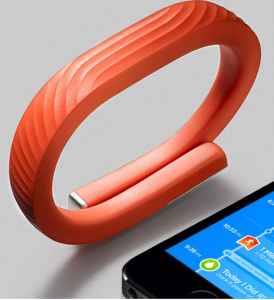This was the Christmas when the quantified self might have been you. A Consumer Electronics Association (CEA) report found that consumer interest in fitness devices has risen to 13%. Dedicated wearable fitness device ownership has tripled year-over-year and now sits at 9%. CEA also predicts that revenues from fitness and activity tracking devices as a whole will surpass $1 billion in 2014.
Around me, many people received the new Jawbone Up24, the Fitbit, or the Nike Fuel Band. Less common, but still prevalent, were the Withings connected scale and tracker and the Misfit Shine. And a second, three times larger cohort of Google Glass Explorers are now out taking photos of you in public places.
If you received one of these devices, you’ll soon find out what I already know: they’re not ready for prime time. The Fitbit Flex is difficult to get on and off the wrist, and non-intuitive to operate; the instructions have become as minimalist as those of Apple products, although their ease-of-use is not at all like Apple’s legendary user experience.
The Shine doesn’t last very long; my six-month-old device missed my entire morning exercise yesterday, and “cheated” me of 3500 potential steps. Today it shows no activity on the app, although my other tracker, the JawboneUp24 shows 5200 steps. But the new JawboneUp24 doesn’t even have an Android app upon release.
We are paying to beta test these products. The anger of thousands of Android phone owners who received the Up24 for Christmas and can’t use it for lack of an app has already been documented on the Jawbone forums. When will companies learn that releasing a game console with no games or a wearable with no apps is not releasing a complete product?
Google Glass is especially at fault, because its cost is so steep — still $1600 to purchase, even though it’s not a consumer product yet and has the same geeky look it had in the first version, with an added ear bud that makes it look even stranger. (And a completely non-intuitive interface that has to be taught to each purchaser.)
Worse yet, there is still a paucity of apps that aren’t the same as those on the phone. Right now, almost nothing can be done with Glass that can’t be similarly done with a smart phone, except perhaps surgical consultations. These medical applications are the best use case right now for Glass.
In addition to the non-intuitive user interfaces, all wearables have another flaw: the data they collect is only marginally accurate and minimally useful, and could be collected by a $20 pedometer. Moreover, each device has a proprietary algorithm for detecting activity other than walking or running, so you don’t know what your activity levels actually are. They may vary from device to device.
Calories still have to be entered manually, and on most devices the sleep tracking is minimal — you have to tell the device when you go to sleep, and the accelerometer knows when you awaken only because you start moving. Deep sleep is tracked by lack of movement.
Saving the worst for last: what do you, the ordinary person, DO with the data you are collecting on yourself? How many steps should you be taking for your age? For your health conditions? To prevent disease?
Wearables will not be truly useful until they do something akin to what pacemakers — the first real wearables — do: collect data and interpret it to make real changes that keep the wearer alive. Only when they can make us healthier without us having to do anything consciously will wearables have achieved their real promise.



